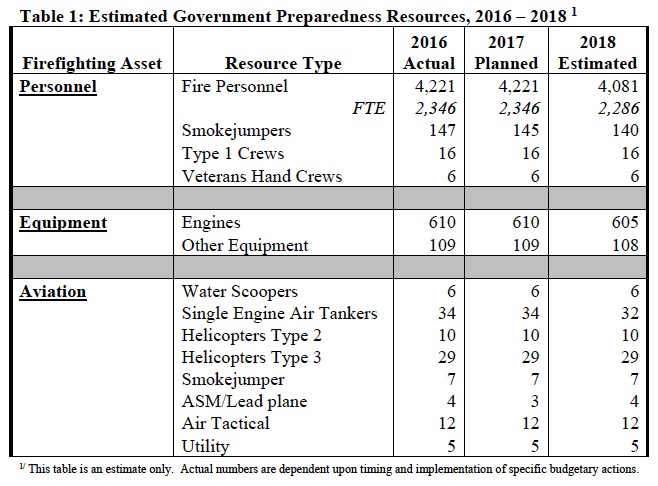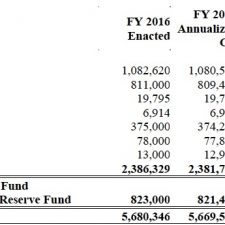Above: The President’s proposal for funding wildland fire in the U.S. Forest Service in Fiscal Year 2018. Source: USFS.
(Originally published at 6 p.m. MST November 9, 2017)
While the federal government keeps throwing additional billions of dollars at the Department of Defense to fund our adventures in countries on the other side of the world, the budget for the war against wildfire in our homeland would be cut in some areas while most functions would remain flat if the President’s proposed budget for Fiscal Year 2018 is approved by Congress.
In May the President proposed budgets for the Forest Service and the four primary land management agencies in the Department of the Interior: Fish and Wildlife Service, Bureau of Land Management, National Park Service, and the Bureau of Indian Affairs. However, Congress, as usual, has not finalized appropriations bills for these agencies for Fiscal Year 2018 which started October 1, 2017. The House passed a version in September, but the Senate has yet to take meaningful action.
The agencies have been operating on a continuing resolution (CR) which expires December 8. It is likely that some kind of showdown will happen around that date, with the worst case scenario being a government shutdown. Or, they could keep passing successive CRs for the rest of the fiscal year, which would lock the funding into the FY 2017 numbers. Of course, CRs were in effect for all of FY 2017. Apparently our elected Senators and Representatives think they have better things to do than fund the government.
If Congress actually does pass a funding bill for these land management agencies, the line by line details and numbers will most likely be different from the President’s proposals, but below we spell out what the administration would like to see happen this fiscal year that started October 1.
Forest Service
In the FS as a whole, the President would like to reduce the number of employees (jobs), cutting the number of staff-years by 5.7 percent. Wildland fire personnel in the FS would remain the same — a total of 10,000, including 67 Interagency Hotshot Crews, 7,940 other firefighters, 320 Smokejumpers, and 400 Fire Prevention Technicians. Fire Suppression would be funded at the 10-year average.
The exact numbers and trends are difficult to track because the Base 8 (the first 8 hours of a firefighter’s regular work day) will now be paid out of Preparedness rather than Suppression. And funds for Hazardous Fuels are shifting from fire funding to National Forest System accounts.
In 2017 the FS reduced the number of the largest helicopters, Type 1, from 34 to 28. The President aims to retain that smaller number. Type 2 and 3 helicopters would remain the same at 33 and 46, respectively. The two water-scooping air tankers in the FS would be eliminated completely, while they add one Single Engine Air Tanker, up from zero in 2017. The FS looked at the two years they had the scoopers as an experiment, even though they have been used successfully in Canada, France, Greece, and Spain for decades.
In 2002 the FS had 44 large air tankers on exclusive use contracts. In 2017 they had 20, consisting of 16 Next Generation air tankers and 4 Legacy P2V’s. With the 50+ year old P2V’s now retired, the agency expects to have “up to 20” Next Gen air tankers in FY 2018.
The budget proposal includes funding for only one of the seven HC-130H aircraft obtained from the Coast Guard in December, 2013 that are supposedly being converted into air tankers. The one that has been used for a couple of years is still not completely transformed, and is using a borrowed pressurized Modular Airborne FireFighting System for dispensing retardant rather than employing a conventional permanent (but removable) internal gravity-powered tank.
The budget document has a rather cryptic sentence about air tankers:
Beginning in 2018, the Forest Service will transition to a full cost recovery business model for aviation utilized by cooperating agencies.
We asked a few Washington Office folks what that meant, and they either didn’t know or failed to respond to our inquiry. One person told us that unclear writing in the document could be the result of a changing of the guards and the reviewers not fully being in place at the Departments and the Office of Management and Budget.
The agency has always charged cooperating agencies for the use of FS aircraft, but it sounds like the price will increase. They may tack on in addition to the hourly rate, additional charges such as working capital fund fees that go toward purchasing replacement aircraft at the end of its life cycle.
The President wants to eliminate the agency’s $6,901,000 contribution to the Joint Fire Science Program (JFSP) which receives its funding through the FS and the Department of the Interior (DOI). According to the budget proposal document:
The JFSP would focus on completing existing projects and standing down science exchange with managers. New research in the Smoke Management and in the Fuels Treatment lines-of-work would be eliminated, as would new research in the Emerging Management Needs initiative. General fire research in the agency would be conducted through the National Fire Plan and the Forest and Rangeland Research appropriations.
The Department of the Interior intends to cut their JFSP contribution in half, down to $3,000.
The web site for the JFSP describes their work as “funding scientific research on wildland fires and distributing results to help policymakers, fire managers and practitioners make sound decisions”.
The total budget for all research in the FS would be cut by 16 percent, from $329 million to $276 million.
Department of the Interior
The 2018 budget request for DOI’s discretionary Department-wide Wildland Fire Management program is $873.5 million. This is a decrease of $118.3 million, or 12 percent, from FY 2017. It would mean a reduction in Full Time Equivalent employees (FTE) from 3,586 to 3,401, or 5 percent.
The number of “fire personnel” would be cut by 140 personnel (jobs) from 4,221 to 4,081, or 3 percent. Smokejumpers would be reduced from 145 to 140, or 3 percent, and engines from 610 to 605, or 1 percent.
The numbers of all DOI firefighting aircraft would remain the same, except single engine air tankers would be cut from 34 to 32, or 6 percent.

As stated above, the DOI’s contribution to the Joint Fire Science Program would be cut in half, to $3 million, while the FS will eliminate their share of funding the program.
Thanks and a tip of the hat go out to Bean.
Typos or errors, report them HERE.


Well when you have agencies like the Forest Circus screwing the pooch on tanker contracts then ya, hell with them! Cut their budget and make them start making good decisions! Throwing money at fires doesn’t put them out…especially when extremely poor decisions are made by decision makers.
Every year the $$$ goes UP…right along with the size and intensity of the fire…
So did the Sccopper’s lose there EU contact ? Any one know what Aeroflite’s plan is going to be with these Aircraft?
Absolutely crazy after another terrible fire year. President isn’t so great at “making America great again” when he’s undercutting critical programs that affect Americans.
looks like an increase would be in order.
Maybe if one of the Presidents golf course clubs is destroyed by fire he would change his mind.